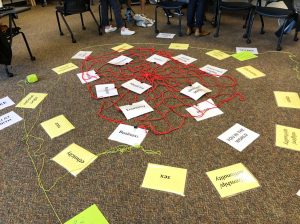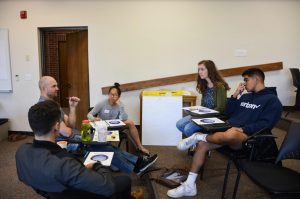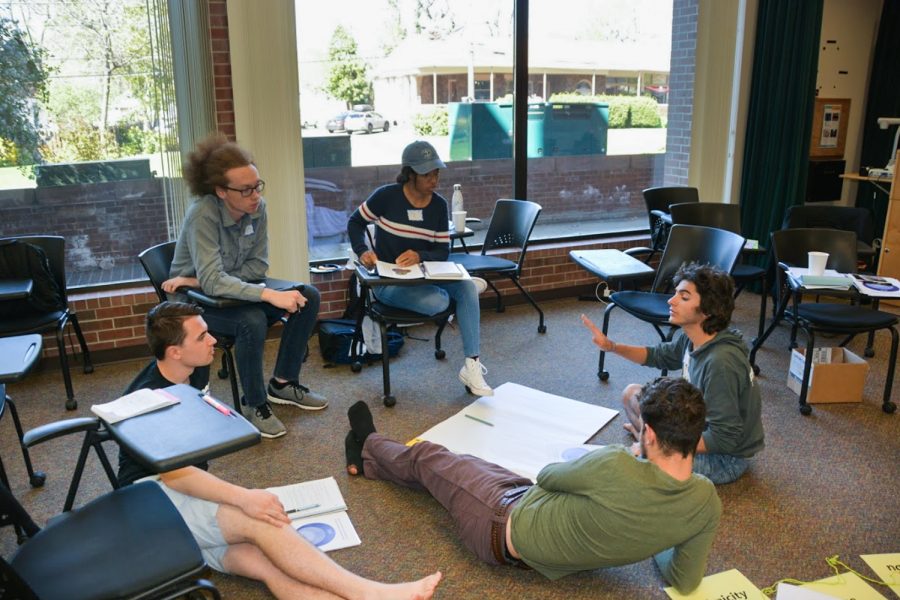Intergroup Dialogue Retreat Promotes Student Leadership
April 25, 2019
About twenty Whitman students gathered together for the Intergroup Dialogue Retreat on Apr. 20 and 21. The retreat, according to Helen Kim, Interim Vice President for Diversity, Equity and Inclusion and co-facilitator of the session, was designed as a workshop for students to learn and experience the intergroup dialogue model.
“[Intergroup dialogue] is a model that’s built on a particular curriculum that emphasizes particular ways of listening, of sharing and of dialoguing — all those three rungs on the stool of communication so that people who are different across social identities in particular can collaborate to try to intervene in instances of oppression,” Kim said.
Conversations around creating the retreat started in 2006, after the blackface incident on campus. In 2016, twenty faculty, staff and students were trained in intergroup dialogue, and then another session for faculty and staff took place in January 2019. Last weekend’s session marks the first student-focused session for intergroup dialogue. Kim believes there was a significant need for a student retreat.
“There’s a real hunger and a thirst for this type of knowledge and learning and model for change-making among students, and it was very palpable amongst the group,” Kim said.
The idea of intergroup dialogue was advanced by Dr. Ratnesh Nagda, who first studied and taught it in the 80s. Nagda helped lead the facilitation of the retreat, and trained Kim, Associate Dean of Students Juli Dunn and Head Women’s Tennis Coach John Hein to be co-facilitators before the retreat.
Nagda believes that the retreat was intended to help student leaders collaborate to make change.

The Intergroup Dialogue Retreat taught students skills for engaging in dialogue and was offered for the first time to students this year.
“We are all coming to a learning environment with knowledge of our lived experiences, knowledge of our past experiences, so how can we build knowledge together ground up versus top down?” Nagda said.
Intergroup dialogue also consists of building skills around dialogue, exploring identities, and seeking awareness of interactions around difference on campus.
Kim says that the retreat focused on the question of conversation about and amongst difference.
“How do we think about communicating across lines of difference for the purposes of intervening in situations of oppression?” Kim said. “Not just connection across difference, but communication across difference.”
Lia Beatty, a sophomore who attended the retreat, characterized it as a place to talk deeply about intergroup collaboration.
“It was an intentional space for those of us who wanted to really dig in and dissect what dialogue meant and how to use it… and to dialogue about issues that we don’t talk about on campus, yet are pervasive and very relevant,” Beatty said.
Beatty thinks the retreat was successful in supporting spaces of leadership and student teamwork.
“I would definitely consider the retreat one of the better experiences I’ve had on campus,” Beatty said. “It was a very intentional space. I saw a very diverse crowd, I think everyone who was there wanted to be there, and wanted to grow. Even the group itself developed.”
Nagda saw that the students at the retreat didn’t settle for obvious solutions.
“I found Whitman students in our leadership and changemaking retreat were not looking for easy answers, but for spaces and tools to constructively engage the difficult questions of difference, identity and power,” Nagda said in an email to The Wire.
Kim felt that the experience, while worthwhile, was also strenuous.
“It’s a really exhausting experience, you start to go deep, you are pushed to be vulnerable pretty quickly and the work itself is really deep,” Kim said.
Beatty agrees that the work was challenging, but she said that without the difficulty, the dialogue wouldn’t occur.
“We were taking the things out of our pockets and we were offering them up to each other without inspecting them nor filtering out the pocket lint,” Beatty said. “We were giving ourselves to each other raw, here. When we are working with… veneers as we regularly do, we can’t actually have genuine or authentic dialogue.”






